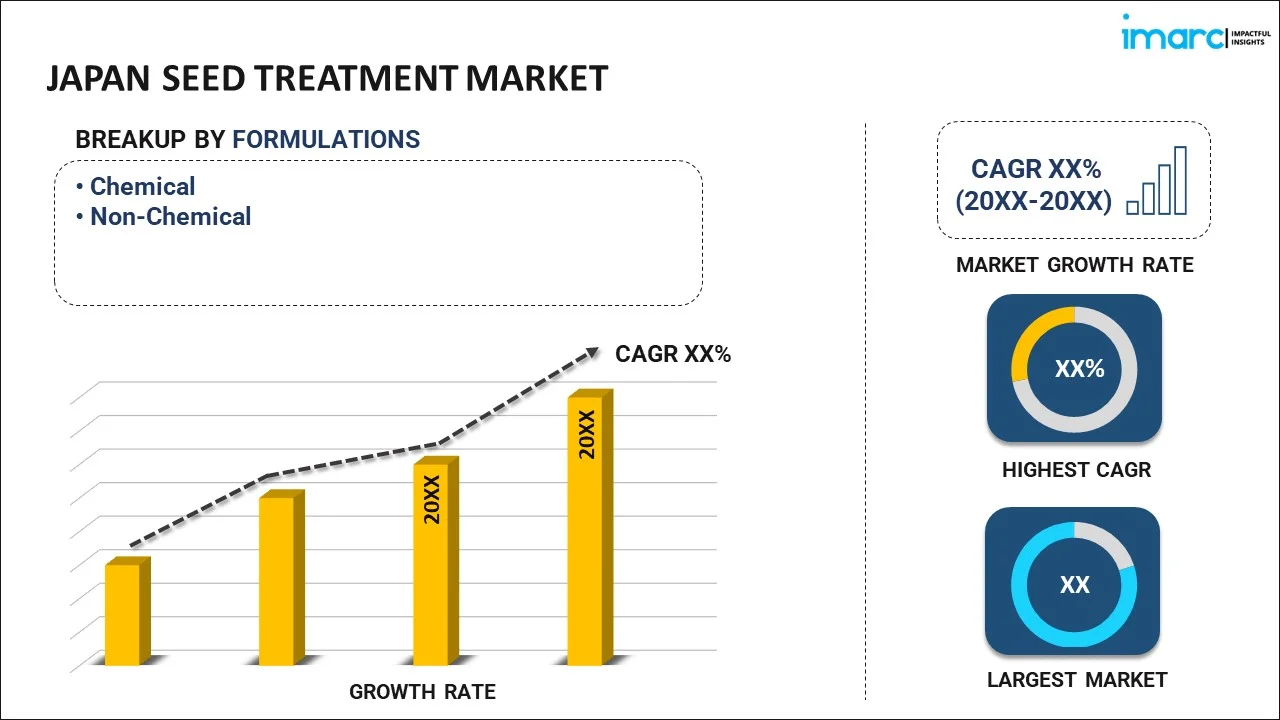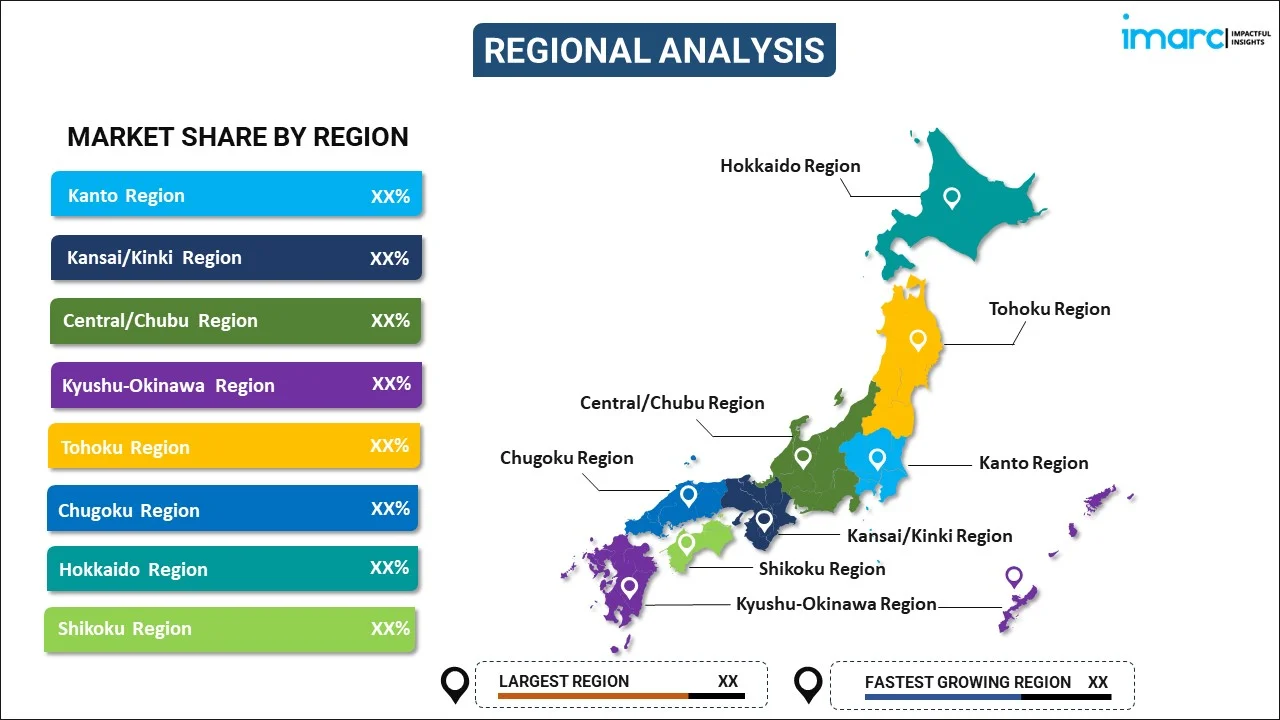
Japan Seed Treatment Market Report by Formulation (Chemical, Non-Chemical), Crop Type (Maize, Soybeans, Wheat, Rice, Canola, Cotton, and Others), and Region 2025-2033
Market Overview:
Japan seed treatment market size reached USD 556 Million in 2024. Looking forward, IMARC Group expects the market to reach USD 997 Million by 2033, exhibiting a growth rate (CAGR) of 6.7% during 2025-2033. The rising adoption of sustainable farming practices, along with the growing focus among farmers on reducing chemical usage, is primarily driving the market growth.
|
Report Attribute
|
Key Statistics
|
|---|---|
|
Base Year
|
2024 |
|
Forecast Years
|
2025-2033 |
|
Historical Years
|
2019-2024
|
| Market Size in 2024 | USD 556 Million |
| Market Forecast in 2033 | USD 997 Million |
| Market Growth Rate (2025-2033) | 6.7% |
Seed treatment is an agricultural practice that involves the application of various chemical or biological substances to seeds before they are planted. The purpose of seed treatment is to protect seeds and young seedlings from a wide range of pests, diseases, and environmental stress factors. These treatments can include fungicides to prevent fungal infections, insecticides to deter insect pests, and even biological agents like beneficial microorganisms to enhance plant growth and disease resistance. Seed treatment is an effective and efficient way to safeguard crops during their early stages of growth, as it provides protection right from the start, reducing the need for post-emergence treatments and promoting healthier, more vigorous plants. This practice contributes to improved crop yields, reduced environmental impact through targeted pesticide application, and ultimately, more sustainable and productive agriculture.
Japan Seed Treatment Market Trends:
The Japan seed treatment market is a pivotal segment within the country's agriculture and agribusiness sector. Renowned for its commitment to technological innovation and sustainable farming practices, Japan has been actively adopting and advancing seed treatment solutions. Key factors contributing to the growth of this market include the need to enhance crop productivity, ensure crop health, and reduce the environmental impact of agriculture. Japanese farmers are increasingly recognizing the benefits of seed treatment, which involves the application of pesticides, fungicides, and beneficial microorganisms to seeds before planting. This practice provides early protection to emerging plants, improving resistance to pests and diseases. As Japan places a strong emphasis on sustainable agriculture and reducing chemical usage, seed treatment aligns with the country's goals of environmentally responsible farming. Collaboration between the agricultural industry, research institutions, and government initiatives further fosters innovation in seed treatment techniques. The Japan seed treatment market is thus positioned to play a pivotal role in advancing agricultural practices that are not only efficient and productive but also environmentally sustainable.
Japan Seed Treatment Market Segmentation:
IMARC Group provides an analysis of the key trends in each segment of the market, along with forecasts at the country level for 2025-2033. Our report has categorized the market based on formulation and crop type.
Formulation Insights:

- Chemical
- Non-Chemical
The report has provided a detailed breakup and analysis of the market based on the formulation. This includes chemical and non-chemical.
Crop Type Insights:
- Maize
- Soybeans
- Wheat
- Rice
- Canola
- Cotton
- Others
A detailed breakup and analysis of the market based on the crop type have also been provided in the report. This includes maize, soybeans, wheat, rice, canola, cotton, and others.
Regional Insights:

- Kanto Region
- Kansai/Kinki Region
- Central/ Chubu Region
- Kyushu-Okinawa Region
- Tohoku Region
- Chugoku Region
- Hokkaido Region
- Shikoku Region
The report has also provided a comprehensive analysis of all the major regional markets, which include Kanto Region, Kansai/Kinki Region, Central/ Chubu Region, Kyushu-Okinawa Region, Tohoku Region, Chugoku Region, Hokkaido Region, and Shikoku Region.
Competitive Landscape:
The market research report has also provided a comprehensive analysis of the competitive landscape in the market. Competitive analysis such as market structure, key player positioning, top winning strategies, competitive dashboard, and company evaluation quadrant has been covered in the report. Also, detailed profiles of all major companies have been provided.
Japan Seed Treatment Market Report Coverage:
| Report Features | Details |
|---|---|
| Base Year of the Analysis | 2024 |
| Historical Period | 2019-2024 |
| Forecast Period | 2025-2033 |
| Units | Million USD |
| Scope of the Report | Exploration of Historical and Forecast Trends, Industry Catalysts and Challenges, Segment-Wise Historical and Predictive Market Assessment:
|
| Formulations Covered | Chemical, Non-Chemical |
| Crop Types Covered | Maize, Soybeans, Wheat, Rice, Canola, Cotton, Others |
| Regions Covered | Kanto Region, Kansai/Kinki Region, Central/ Chubu Region, Kyushu-Okinawa Region, Tohoku Region, Chugoku Region, Hokkaido Region, Shikoku Region |
| Customization Scope | 10% Free Customization |
| Post-Sale Analyst Support | 10-12 Weeks |
| Delivery Format | PDF and Excel through Email (We can also provide the editable version of the report in PPT/Word format on special request) |
Key Questions Answered in This Report:
- How has the Japan seed treatment market performed so far and how will it perform in the coming years?
- What has been the impact of COVID-19 on the Japan seed treatment market?
- What is the breakup of the Japan seed treatment market on the basis of formulation?
- What is the breakup of the Japan seed treatment market on the basis of crop type?
- What are the various stages in the value chain of the Japan seed treatment market?
- What are the key driving factors and challenges in the Japan seed treatment?
- What is the structure of the Japan seed treatment market and who are the key players?
- What is the degree of competition in the Japan seed treatment market?
Key Benefits for Stakeholders:
- IMARC’s industry report offers a comprehensive quantitative analysis of various market segments, historical and current market trends, market forecasts, and dynamics of the Japan seed treatment market from 2019-2033.
- The research report provides the latest information on the market drivers, challenges, and opportunities in the Japan seed treatment market.
- Porter's five forces analysis assist stakeholders in assessing the impact of new entrants, competitive rivalry, supplier power, buyer power, and the threat of substitution. It helps stakeholders to analyze the level of competition within the Japan seed treatment industry and its attractiveness.
- Competitive landscape allows stakeholders to understand their competitive environment and provides an insight into the current positions of key players in the market.
Need more help?
- Speak to our experienced analysts for insights on the current market scenarios.
- Include additional segments and countries to customize the report as per your requirement.
- Gain an unparalleled competitive advantage in your domain by understanding how to utilize the report and positively impacting your operations and revenue.
- For further assistance, please connect with our analysts.
 Inquire Before Buying
Inquire Before Buying
 Speak to an Analyst
Speak to an Analyst
 Request Brochure
Request Brochure
 Request Customization
Request Customization




.webp)




.webp)












